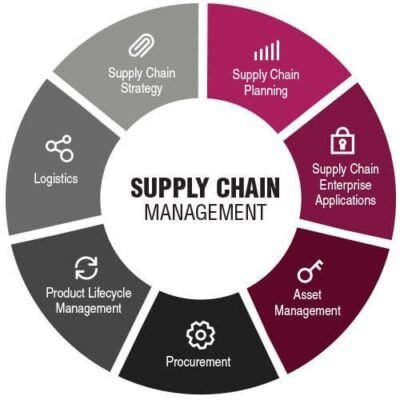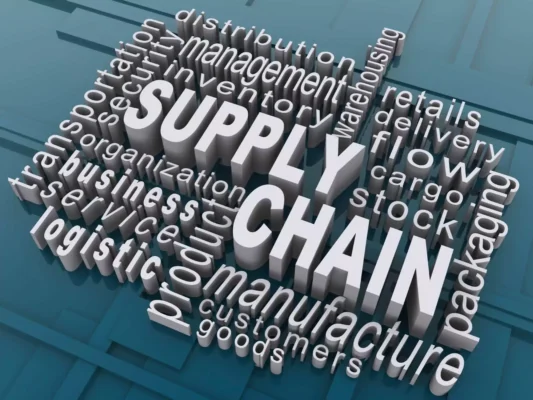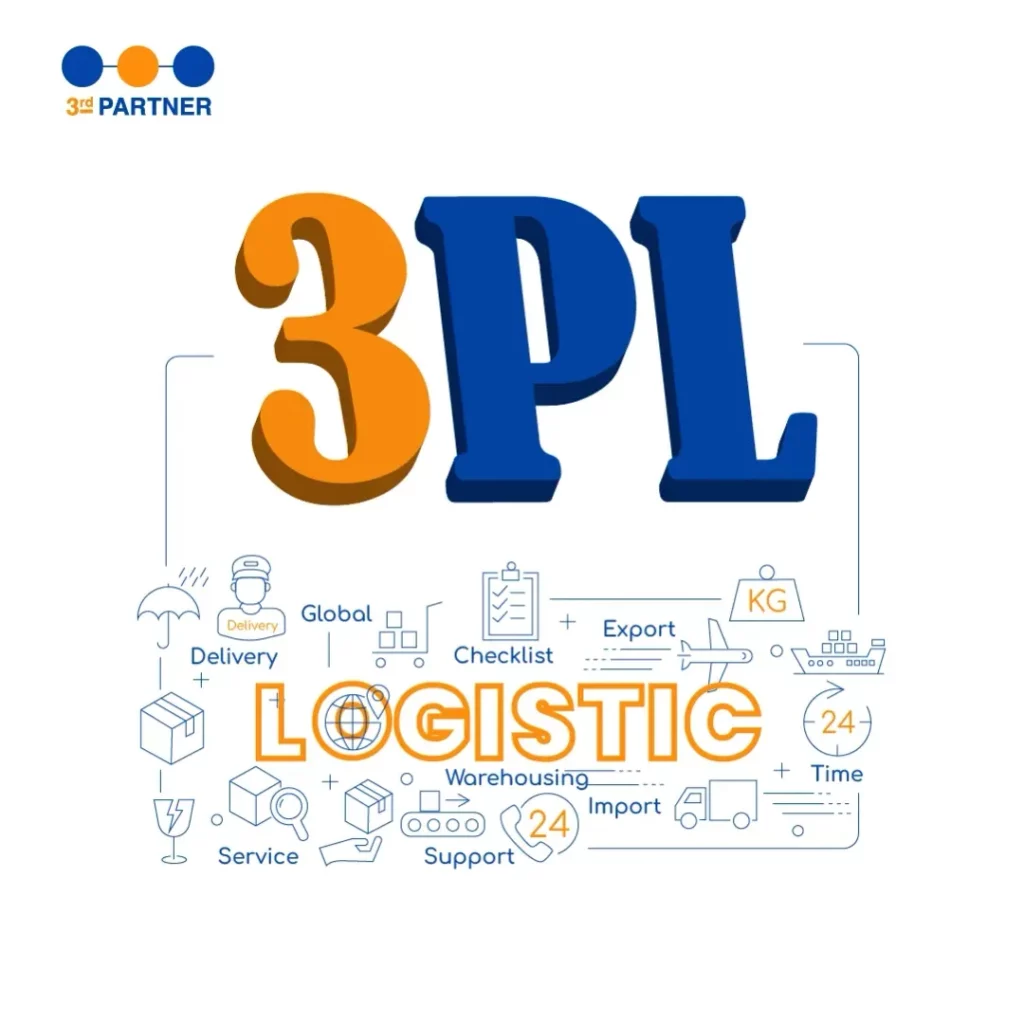The flow of goods and information is crucial for the global economy, with supply chain management playing a key role in ensuring efficiency and success. Saudi Arabia, strategically located at the crossroads of three continents, is emerging as a global logistics hub thanks to Vision 2030 and significant investments in infrastructure and innovation. Supply chain logistics companies are leading this transformation, and this article will explore their strategies, successes, and challenges, highlighting Saudi Arabia’s growing influence in global logistics.
What is a Supply Chain?
At its core, a supply chain is the journey that a product takes from its very beginning to the moment it reaches your hands. It’s a complex network that involves everything from sourcing raw materials to manufacturing, transportation, and finally, delivery to the consumer. Think of it as the behind-the-scenes magic that ensures products are available when and where they’re needed.

Imagine walking into a store and finding your favorite product on the shelf. That simple moment is the result of a well-coordinated effort involving multiple players suppliers, manufacturers, transporters, and retailers all working together to make it happen.
Supply chain logistics companies play a crucial role in keeping this process running smoothly. They manage the flow of goods, optimize routes, and ensure that everything arrives on time, all while maintaining the quality of the products. Without these companies, the everyday conveniences we take for granted would be much harder to come by.
Steps Followed by Supply Chain Logistics Companies
The supply chain is a carefully orchestrated process that transforms raw materials into finished products and delivers them to consumers. Each step is crucial, and when done right, it ensures that goods are available when and where they’re needed.

Let’s break down the key steps in a typical supply chain.
-
Sourcing Raw Materials
The journey begins with sourcing raw materials. This step involves finding and acquiring the essential components needed to create a product. Whether it’s cotton for clothing, metals for electronics, or ingredients for food, the quality and availability of these materials are the foundation of the entire supply chain.
-
Manufacturing
Once the raw materials are in hand, they move to the manufacturing stage. Here, they are transformed into finished products. This step involves various processes such as assembly, fabrication, and quality control. The goal is to create products that meet the required standards and are ready for the market.
-
Transportation
After manufacturing, the products need to be transported to different locations, such as distribution centers, warehouses, or retail stores. Supply chain logistics companies play a vital role in this step, ensuring that goods are moved efficiently and cost-effectively. They handle everything from choosing the best transportation routes to managing customs and regulations.
-
Warehousing
Before products reach the shelves, they often spend some time in warehouses. This step involves storing goods safely until they are needed. Effective warehousing ensures that products are available to meet demand without delays. It also plays a role in managing inventory levels and reducing the risk of overstocking or stockouts.
-
Distribution
The distribution step is where products are delivered to their final destination, whether that’s a retail store, an online customer, or a business. This stage is all about getting the right products to the right place at the right time. Supply chain logistics companies ensure that this process runs smoothly, coordinating deliveries and managing any last-mile challenges.
-
Customer Service and Returns
Finally, customer satisfaction is key to a successful supply chain. This step involves handling customer inquiries, managing returns, and ensuring that any issues are resolved quickly. A well-managed supply chain doesn’t just deliver products; it also ensures a positive customer experience, which is crucial for building long-term loyalty.
Each of these steps is interconnected, and when managed effectively, they create a seamless flow of goods from the origin to the consumer. Supply chain logistics companies are essential at every stage, providing the expertise and infrastructure needed to keep the supply chain running like a well-oiled machine.
Models of Supply Chain

The supply chain isn’t a one-size-fits-all process. Different industries and businesses require different approaches to managing the flow of goods and services. To meet these diverse needs, several supply chain models have been developed, each with its own strengths and focus areas. Let’s explore some of the most common models and how supply chain logistics companies utilize them to optimize operations.
- Continuous Flow Model: Suited for businesses with steady demand, this model ensures smooth and consistent production and delivery, focusing on efficiency and minimizing downtime.
- Fast Chain Model: Designed for industries with short product life cycles, such as fashion and electronics. It emphasizes speed and agility to quickly respond to market trends and customer preferences.
- Efficient Chain Model: Ideal for cost-sensitive markets, this model focuses on minimizing expenses across the supply chain. It involves optimizing routes, negotiating rates, and leveraging technology to cut costs.
- Agile Model: For businesses needing flexibility, this model adapts quickly to changes in demand and market conditions, ensuring rapid response without sacrificing quality.
- Custom-Configured Model: Combines elements from various models to meet specific industry needs, allowing businesses to tailor their supply chain strategy.
- Flexible Model: Best for industries with fluctuating demand, this model supports quick adjustments in production and delivery to handle variable needs effectively.
Best Practices of Supply Chain Logistics Companies

Effective supply chain management requires strategic planning and execution to ensure smooth operations and competitive advantage. Here are key strategies that supply chain logistics companies use to optimize performance:
-
Demand Forecasting
By predicting future demand, businesses can plan inventory levels, production schedules, and procurement more effectively. This helps prevent both overstocking and stockouts, ensuring products are available when needed and reducing excess inventory costs.
-
Inventory Management
Efficient inventory management involves balancing the need to have enough stock to meet demand while minimizing holding costs. Strategies like just-in-time (JIT) inventory, where materials arrive only as needed, and safety stock, which acts as a buffer against unforeseen demand spikes, are commonly used. Supply chain logistics companies employ sophisticated systems to track inventory levels and optimize reorder points, improving overall efficiency.
-
Supplier Relationship Management
Building strong relationships with suppliers is crucial for ensuring reliable and timely delivery of materials. This strategy involves selecting and maintaining partnerships with suppliers who meet quality, cost, and delivery requirements. Collaborative approaches, such as regular communication and performance reviews, help address issues proactively and foster long-term partnerships.
-
Lean Manufacturing
Lean manufacturing aims to reduce waste while increasing value at every stage of the production process. This strategy involves streamlining processes, reducing excess inventory, and eliminating inefficiencies. By adopting lean principles, companies can lower production costs, improve product quality, and shorten lead times.
-
Technology Integration
Leveraging technology is vital for modern supply chain management. Advanced tools like supply chain management (SCM) software, data analytics, and automation technologies help optimize operations. Technologies such as real-time tracking, blockchain, and artificial intelligence (AI) enhance visibility, streamline processes, and improve decision-making.
-
Risk Management
Effective risk management entails recognizing, evaluating, and addressing potential risks within the supply chain. Strategies include diversifying suppliers, developing contingency plans, and investing in robust cybersecurity measures. By proactively managing risks, companies can reduce disruptions and maintain supply chain continuity.
-
Sustainability Initiatives
Sustainability has become a key focus in supply chain strategies. Companies are increasingly adopting practices that minimize environmental impact, such as reducing carbon emissions, optimizing energy use, and using eco-friendly materials. Supply chain logistics companies play a role in implementing these initiatives and ensuring compliance with sustainability standards.
-
Global Sourcing
Global sourcing involves procuring materials and components from international suppliers to take advantage of cost savings, quality improvements, or unique capabilities. This strategy requires careful management of global logistics, including transportation, customs, and regulatory compliance, to ensure smooth and cost-effective sourcing.
-
Agile Supply Chain
An agile supply chain is designed to be flexible and responsive to changing market conditions and customer demands. This strategy involves creating adaptable processes and structures that can quickly adjust to fluctuations in demand, supply disruptions, or new market opportunities.
-
Customer-Centric Approach
Placing the customer at the center of supply chain strategies ensures that products and services meet or exceed customer expectations. This approach involves understanding customer preferences, enhancing service levels, and optimizing delivery times to improve satisfaction and loyalty.
Each of these strategies plays a crucial role in optimizing supply chain operations, helping businesses stay competitive and responsive in a dynamic market environment. Supply chain logistics companies use these strategies to drive efficiency, reduce costs, and enhance overall performance.
Conclusion
Adopting best practices in supply chain management is essential for driving operational excellence and achieving strategic objectives. By focusing on accurate demand forecasting, efficient inventory management, and fostering strong supplier relationships, businesses can enhance their supply chain’s reliability and efficiency.
Ready to elevate your supply chain operations? Partner with “3rd Partner”, one of the best supply chain logistics companies in the industry. Contact us today to learn how we can transform your supply chain and drive your business success. Reach out now and take the first step.











